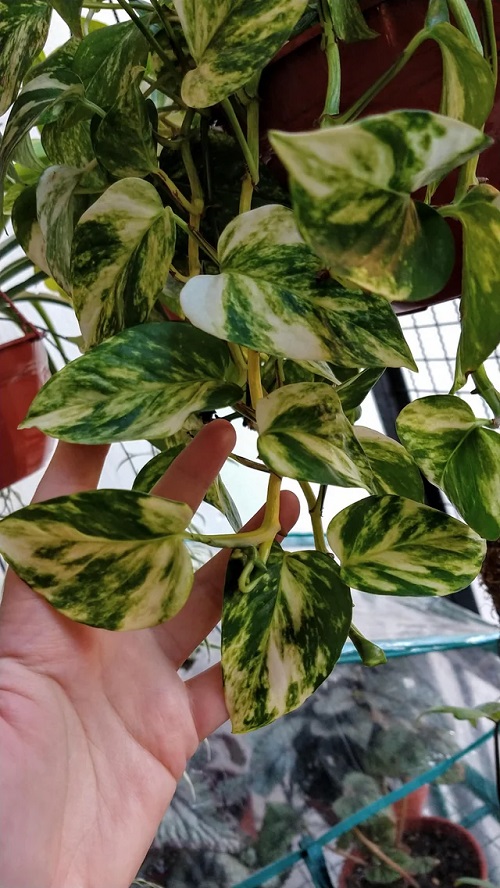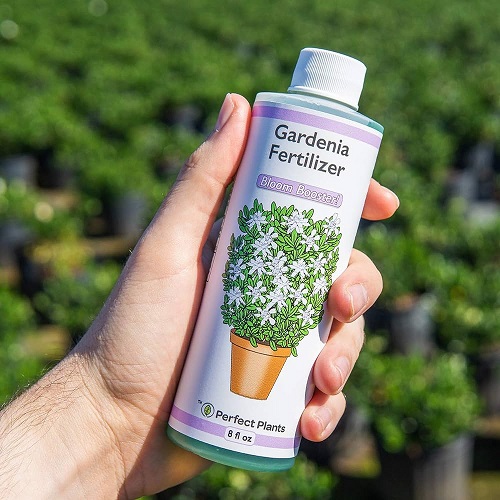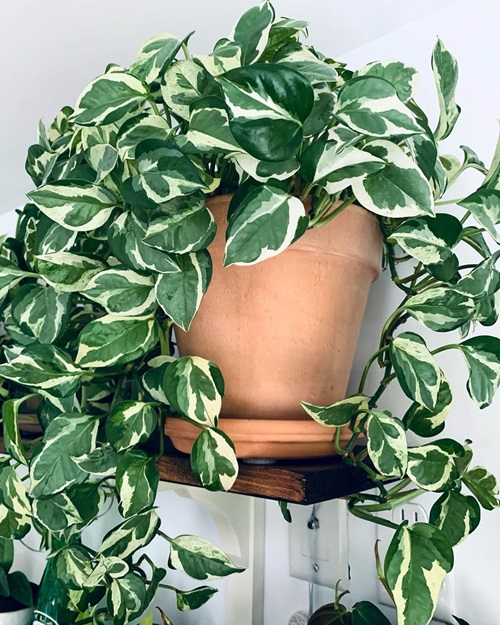Are you looking for some tricks to Increase Variegation in Pothos Plant? Well, we have some fantastic ones that actually work!
Variegation in pothos depends on a lot of factors that can make or break the colors and streaks on its foliage. Let’s understand them in detail to get the best hues on its leaves!
Avoid these pothos growing mistakes
How to Increase Variegation in Pothos Plant?
1. Grow the Most Variegated Varieties
Do understand the fact that not every pothos is variegated – for example, Cebu Blue Pothos has a striking blue-green foliage – but it stays solid in color – without any markings, splashes, or streaks.
So no matter how much you’ll try, it won’t get a variegation. Same goes for Neon Pothos, too.
If you want the best colors on the leaves, then pick out varieties that naturally have deeper variegation. Marble Queen Pothos, Golden Pothos (The quintessential Pothos for sure!), Manjula Pothos, and Snow Queen Pothos are some of the most distinctive ones with the best color palette on the foliage.
Best variegated pothos plants
2. Do Not Treat it as a Typical Low Light Houseplant
When it comes to pothos, we think it requires minimum light and will do just right in a dark room. Well, this may be right for a solid color pothos, or philodendron for that matter, but for the variegated varieties – NO! They need more light!
Why Light is Essential?
As we all know, photosynthesis is vital for every plant to survive and sunlight is the basic need for it. Lack of light forces the specimens to reduce the variegation, as photosynthesis primarily occurs in the green parts of the leaf, where chlorophyll is present – a vital component for absorbing light.
How Lack of Light Affects Variegation?
In variegated leaves, areas lacking chlorophyll cannot absorb light efficiently. This means they don’t contribute in the photosynthesis, potentially reducing the plant’s overall ability to produce energy – the reason why plants in low light are not as colorful as the ones that bask in the bright light.
What Needs to Be Done?
I’m not saying you have to expose pothos to the sun all the time – well, not exactly.
All you have to do, is to make sure that the plant gets a minimum of 3-4 hours of direct morning sunlight (Which is mild! Wouldn’t make the leaves scorch!), or you can keep them at a spot where they get indirect light all day – this will ensure the colors stay bright and the plant fills its foliage with colors!
3. Use Cuttings from the Most Variegated / Colorful Specimen
Well, this is not to increase the variegation in pothos plant, but this allows you to have another, more colorful plant in your collection!
How it works? When you take a cutting from the most variegated specimen, it automatically guarantees that the plant you’re going to propagate with it, will have the exact same coloration as the donor plant.
Which means, you will have another, most colorful specimen in your collection!
Pro Tip: If you want to grow a big leaf pothos – you can use this same trick! Snip a cutting from a large leaf specimen for propagation – you’ll have a similar plant!
4. Go for Bloom Boosting Fertlizers
Before you jump the gun, hear me out! Pothos, as we all know, are not known for producing flowers. However, phosphorus (Which is key nutrient that promotes strong flower development and vivid coloration) enhances the overall flowers and color development in the blooming specimens.
What you can do is:
- Add a handful of a bone meal in the soil (Per pot) once, in the growing season. This, being rich in phosphorus, will help the coloring on the pothos’ leaves.
OR
- Go for liquid formulations like 10-30-20 (Means the blend contains 30% phosphorus). Dilute it to half of its strength, and use it once in 4-5 weeks. This will surely enhance the coloration on the leaves!
5. Keep the Dust Away
Pothos have a large leaf area as compared to the most of the typical houseplants that we all grow. It promotes better absorption of light, which equates to better photosynthesis, which we all know, is crucial for the overall plant development and ultimately, the color on the foliage.
So, it is essential that you clean the foliage from time to time. The best way to do it, is to use two soft cotton cloths:
- Dampen the first one with water and take out the dirt by wiping the leaves softly.
- Dampen the second one as well, but this time, add a 6-8 drops of milk and then wipe the leaves. Milk is pro at keeping fungal infections like powdery mildew at bay, so it will not only add shine to the leaves (Making them appear more vibrant than they actually are), but will also keep the plant safe.
So there you have it, folks. Some tips that I have personally used on my varigated pothos to make them more colorful than every specimen out there! Try these and do lemme know! I’ll be all ears!





